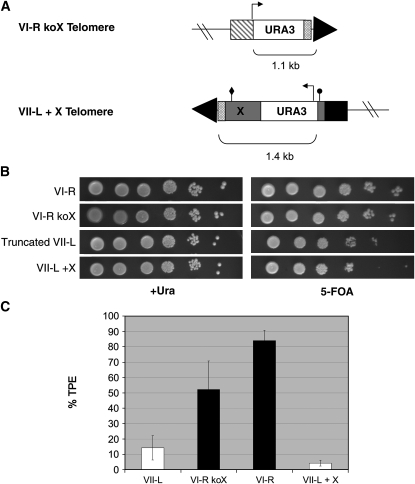Figure 2.—
The X element requires chromosomal context to function. (A) Construction of VI-R koX and VII-L + X telomere reporter strains. The VI-R koX TPE reporter was created via integration of the URA3 gene flanked by an upstream segment of unique DNA (YFR057w, striped box) and the final 56 bp of the X element (crosshatched box), knocking out most of the X element, including the X-ACS and Abf1p binding site. The VII-L + X TPE reporter was created via truncation of the VII-L telomere seed at an upstream segment of unique DNA (ADH4 gene, solid). The VI-R X element was cloned using an upstream primer with the same sequence as the primer used to integrate URA3 at the X-ACS and a downstream primer with the same sequence used to knockout the VI-R X element. This PCR product replaced the URA3 fragment in the VII-L truncation plasmid, pADH4UCAIV (Gottschling et al. 1990). The transcription start site (arrow), X-ACS (circle), and Abf1p binding site (diamond) are positioned identically to their locations in the VI-R strain (see Figure 1A). (B) TPE assays. Tenfold serial dilutions were plated as in Figure 1B. TPE appeared unchanged in the absence of the X element at VI-R and was not enhanced by the presence of the X element on truncated VII-L. (C) Quantitation of TPE. TPE at VI-R was reduced (P < 0.02) in the absence of the X element, but was still significantly higher than TPE at VII-L (P < 0.002), which also lacks the X element. The addition of the X element to the truncated VII-L telomere did not increase the level of TPE at that telomere.

